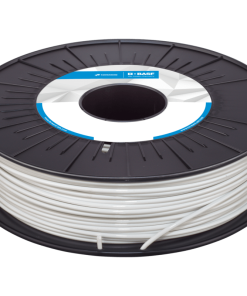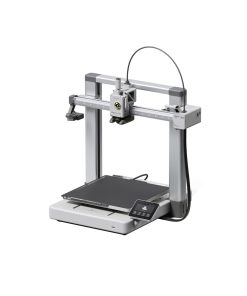Infinite Material Solutions Filament – Caverna™ PP (500G) Nagase Specialty Materials
$ 110,00 $ 44,00
Caverna PP
Caverna PP (a polypropylene filament) has a water-soluble phase that dissolves to create a co-continuous microporous morphology.
Product advantages.

Creativity.
Caverna PP offers a unique microporous morphology, opening up a wide range of possible applications.

Consistency.
Caverna PP’s highly uniform pore size and distribution provide outstanding print fidelity.

Water solubility.
When placed in ordinary tap, Caverna PP’s water-soluble phase dissolves to produce a co-continuous microporous foam-like structure.
Co-continuous morphology: what it is, and why it matters.
By melt processing two polymers at near-equal parts, we’re able to create a filament with a co-continuous morphology — which is a consistent distribution of interconnected channels.

Caverna is a unique blend of two immiscible polymers: a soluble material to be removed through dissolution, and an insoluble build material to remain.
After dissolution, the water-soluble phase leaves behind a cave-like network of interconnected channels inside the build material, making it light, soft, and porous.
Disruptive benefits of Caverna PP.
Room for complex, creative builds.
Caverna PP gives you the freedom to design hollow, curved structures with a porous or filtering component where space can be challenging.


Print fidelity.
Throughout your 3D-printed piece, a uniformly distributed and sized microporous morphology is assured every time.
Water-only solubility.
When paired with AquaSys® 120, Caverna PP’s water-soluble phase dissolves along with your support structures.


Varied composite capability.
If a polypropylene (PP) composite is ideal for your industry, Caverna PP offers optimum compatibility with traditional PP materials.
Innovated for automotive to medicine to aerospace – and everywhere in between.
The final structure of Caverna PP allows vapors to pass through while still holding water. Its resemblance to sponge, bone, or filter gives this unique build material an application in almost any industry. From the sole of a shoe to tissue scaffolds to high-tech filters, the uses for Caverna PP are only limited by your imagination.
Creative prototyping.
While PP is typically challenging to build with, Caverna PP is easy to work with, allowing you to experiment more freely — and print complex geometries when supported with AquaSys 120.
End-use products.
With a final structure that’s spongy and flexible while maintaining a consistent pore pattern and size, the industrial opportunities for Caverna PP are wide-ranging.
Finish clean.
With AquaSys 120 as its support, Caverna PP doesn’t require toxic finishing chemicals, making it ideal for manufacturing, medical, and educational uses — while also relieving the waste disposal burden for all users.
Why you should buy Caverna PP.
Caverna PP (a polypropylene filament) is engineered to print uniformly porous pieces that resemble a 3D-printed foam. It’s the first product to launch in the family of Caverna build materials, which features a water-soluble phase that leaves behind a co-continuous microporous morphology.
High-temperature stability.
Caverna PP’s temperature range provides opportunities for industries where porous materials and complex geometries are essential, such as automotive and aerospace.
20–50˚C
CHAMBER
190–250˚C
BUILD PLATE
190–250˚C
NOZZLE
Printing Parameters.
Caverna PP is designed for use in professional-grade, industrial, and prosumer AM printers, such as the Ultimaker S5 and AON3D.
1.75 mm and 2.85 mm filaments.
Caverna PP is available in two sizes, designed for use in fused filament fabrication (FFF) printers.
Robust adhesion.
Caverna PP adheres to PEI build plates. It will also adhere to glass build plates, as long as you use an adhesive (such as a nano polymer adhesive) or a raft of AquaSys 120.
Game-changing versatility.
Caverna PP’s compatibility with standard, nonporous polypropylene materials allows you to print structures with selectively soft and rigid areas.
Easy solubility.
oluble components dissolve at temperatures of 60–80°C after being fully submerged for at least one day.
| Diameter | 1.75mm, 2.85mm |
|---|---|
| Spool Size | 500g |
Professional packing and fast shipping
Due to our longstanding partnership with UPS FedEx DHL and other major global carriers, we are able provide a range of shipping options. Our warehouse staff is highly trained to package your goods exactly as per the specifications we offer. Before shipping the goods are carefully inspected and secured. Everyday we deliver thousands of packages to customers from all over the world. This is a testament to our commitment to be the largest online retailer worldwide. The warehouses and centers for distribution are situated in Europe and the USA.
Orders with more than one item are given processing time for each item.
Before shipping, we will conduct a thorough inspection of the items you've ordered. Currently, most orders are shipped within 48-hours. Expected delivery time is between 3 and 7 days.
Returns
The stock is dynamic and we do not fully manage it because of the fact that multiple stakeholders are involved, including our factory and warehouse. The actual levels of stock can change at any moment. It's possible that the stock may run out after your order has been placed.
The policy is 30 days. If you haven't received the product within 30 days, we are not able to issue a refund or an exchange.
For your item to be returned, it must be unopened and in the same state as you received it in. It must also be in the original packaging.
Related products
3D Printer
3D Printer
3D Printer
3D Printer
3D Printer
3D Printer
3D Printer















































